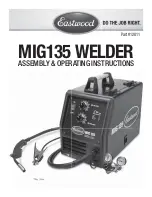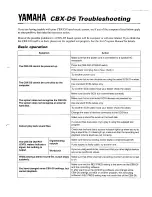
NOTE:
The main power supply operates the
heating elements and the circulating
pumps. A transformer may be used to
power the control circuit. The transformer
and control circuits are overload-protected.
h
For
three-phase applications
, the terminal
blocks are labeled
L1
,
L2
and
L3
(B)
.
h
For
single-phase applications
, use the terminal
blocks labeled
L1
and
L2 (B)
.
2.
Connect the main power ground wire to the ground
block
(A)
.
2.4.2 CUSTOMER INTERFACE
CONNECTIONS
NOTICE
Wiring connections:
Reference electrical schematic
drawings for proper wiring locations; the following are
typical interface locations.
The following customer interface connections are
available for remote control and monitoring:
•
TB2:1/TB2:2
Coolant Fault Signal (C)
The fault signal will indicate a coolant heating system
shutdown, triggered by either the high-limit temperature
control relay or the motor protection switch.
•
TB2:3/TB2:4
Coolant Motor Run Signal (D)
A motor run signal indicates the coolant pump
motor is running. If no signal is present, the coolant
pump motor is not running.
•
TB2:5/TB2:6
Remote On/Off 24 V DC shutdown (E)
When energized, the remote on/off relay will
activate the heating system. When de-energized,
the remote on/off relay will deactivate the heating
system. Use this connection for remote operation of
the heating system when the
local
/
off
/
remote
switch is turned to
remote
.
NOTE:
The
24 V DC shutdown
relay is wired
NO
(normally open)
from the factory. To switch
to NC (normally closed) operation, move
the wire from the
K4:14
terminal to the
K4:12
terminal.
2.4.3 MOTOR ROTATION CHECK
NOTICE
Pump rotation (three-phase only):
For three-phase
applications, check for proper pump rotation prior to
introducing fluid to the pump. Reverse rotation while
the pump is filled with fluid will fail to create proper fluid
circulation.
Figure 7. Main power supply and customer interface connections as
shown in the CMM/CLM control box. Reference electrical schematic
drawing for proper wiring locations; the following illustrations are
typical customer interface locations but may not apply to all models.
A.
Main power ground block
B.
Main power terminal block
C.
Coolant fault signal
D.
Coolant motor run signal
E.
Remote On/Off
24 V DC shutdown
CB2
TCR1
A1
A2
TCR2
A1
A2
TR1
A1
A2
K3
A1
A2
K1
A1
A2
K2
A1
A2
X1
X2
DS2
Y
X1
X2
DS1
G
X1
X2
DS3
R
4
3
3
4
REMOTE
OFF
LOCAL
3
4
3
4
14
11
K4
14
13
K1
K3
11
12
TR1
18
15
15
16
MPS1
13
14
14
13
TCR1
FROM SHEET 1
FROM SHEET 1
BLU
BRN
BLK
TS1
BLU
BRN
BLK
TS2
14
13
K2
K3
21
22
K4
A1
A2
14
11
K5
A1
A2
14
11
K5
SW1-2
SW1-1
SW1-4
SW1-5
TB3:5
TB3:4
TB3:3
TB3:1
TB3:2
TEMPERATURE CONTROL
HIGH LIMIT
LOCAL INDICATOR
REMOTE INDICATOR
FAULT INDICATOR
HIGH LIMIT LATCH
NO FAULT
ELEMENT
MOTOR
TCR1:T2
TCR1:T3
TCR1:T1
TCR2:T2
TCR2:T3
TCR2:T1
TB2:1
TB2:3
TB2:5
TB2:2
TB2:4
TB2:6
FAULT CONTACTS
RUN CONTACTS
24V SHUTDOWN
CUSTOMER INTERFACE
PB1
1
2
3
4
NO FAULT HEATER OFF
SSO
A
B
C D
E
Summary of Contents for CLM
Page 2: ......
Page 6: ...iv installation operation manual cmm clm heating system ...








































